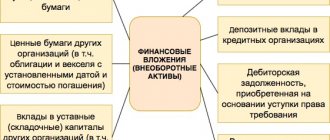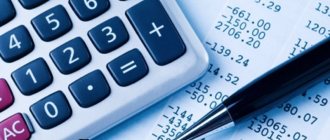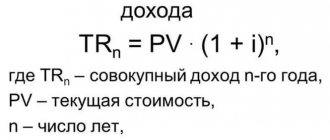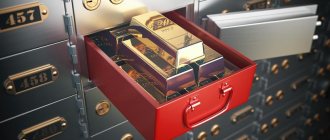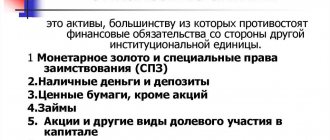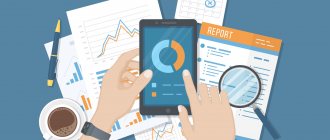Every company has property, which may include money, equipment and other tangible and intangible assets. The property mass is called assets. This is the company's source of income. Assets come in many varieties. To obtain the required value, calculations are required. They are required when paying imputed tax. However, keeping records of assets is important not only for tax deductions. These indicators reflect the state of the company.
What property is classified as non-current assets for balance sheet purposes ?
Composition of non-current assets
Non-current assets are company property that is used many times. This includes objects that have been in use for more than a year. Their cost is more than 15 times the minimum wage, excluding taxes.
How to fill out line 1190 “Other non-current assets” ?
Non-current assets may include:
- funds received from the main activities of the enterprise;
- intangible assets;
- unfinished objects;
- equipment and machinery;
- long-term investments.
Question: Is it possible to apply a VAT deduction if property (including equipment, real estate) is accounted for on account 08 “Investments in non-current assets” (clause 1 of Article 172 of the Tax Code of the Russian Federation)? View answer
This list is not exhaustive. Let's look at each of the component categories. Material VA include :
- building;
- Earth;
- equipment, vehicles;
- furniture that has been in use for more than a year;
- resources in the form of animals and plants;
- trade equipment;
- equipment stored in enterprise warehouses;
- property leased to another person.
do you need to pay corporate property tax on investments in non-current assets ?
Among financial VAs we can highlight:
- bonds with a long-term maturity period;
- shares purchased for the purpose of receiving dividends;
- providing loans;
- various investments.
Intangible non- current assets are:
- Database;
- software developed by the company;
- rights to own land and subsoil;
- licenses to carry out work;
- various patents.
Regardless of which object is being considered, its period of use must exceed a year. If the operating time is shorter, the property will be classified as current assets.
Accounting for non-current assets at an enterprise
To account for operational movements, a separate account is provided for each group of non-current assets by order of the Ministry of Finance dated October 31, 2000 No. 94n and rules for their reflection are given.
Let's look at each group of non-current assets in more detail.
Accounting of intangible assets
Intangible assets are a long-term asset (with a useful life of more than 1 year) without a tangible form, used by an enterprise to obtain financial benefit. Accounting for intangible assets is regulated by PBU 14/2007.
- Intangible assets are reflected in accounting at cost, which includes the amount of costs incurred for its production, acquisition and other associated costs.
- The organization also needs to determine the expected period of use of the asset, which may be equal to the period of the contract concluded for its use or the expected period of income, but not exceed the life of the enterprise itself.
- It is also possible to account for intangible assets with an unformed period of use; in this case, according to clause 23 of PBU 14/2007, depreciation charges are not made on it.
IMPORTANT! The estimated service life of intangible assets should be examined every year for the need for revaluation. This need is indicated by clause 27 of PBU 14/2007.
To reflect intangible assets, the following entry is entered into accounting: Dt 04 Kt 08.
Depreciation charges for intangible assets can be made using one of the three existing methods described in PBU 14/2007. Accruals are made from the beginning of the next month after the asset is accepted onto the balance sheet and continue until it is written off or the entire cost is repaid.
To reflect depreciation in accounting, the following entry is used: Dt 44 (20, 23, 25, 26) Kt 05.
When an intangible asset is disposed of, all depreciation accrued during its use is transferred to the general account “Intangible assets”: Dt 05 Kt 04.
Next, the residual value of the asset is determined and it is written off from the enterprise’s balance sheet by posting: Dt 91 Kt 04.
OS accounting
The conditions for accepting an asset as a fixed asset, as well as the rules for their accounting, are described in PBU 6/01. This category includes:
- building,
- equipment,
- devices and instruments used in work,
- vehicles,
- livestock,
- household equipment and other objects.
Fixed assets are recorded in accounting at their original cost, which can subsequently be revised, but not more than once a year (clause 15 of PBU 6/01).
To accept fixed assets for accounting, it is necessary to determine their future period of use. This is done on the basis of the Classification of fixed assets introduced by Decree of the Government of the Russian Federation dated January 1, 2002 No. 1.
The cost of fixed assets is entered into accounting with the entry: Dt 01 Kt 08.
To calculate depreciation, a credit from the “Depreciation of fixed assets” account is used, corresponding to the accounts that record sales or production costs: Dt 44 (20, 23, 25, 26) Kt 02.
To carry out the disposal of fixed assets from the balance sheet, the current instructions to the Chart of Accounts provide for the possibility of creating subaccount 1 “Disposal of fixed assets” to the main fixed assets account. In this case, the following records are created: Dt 02 Kt 01.1, Dt 91 Kt 01.1.
You can familiarize yourself with the nuances of accounting for fixed assets in accounting and calculating depreciation in the article “Fixed assets in accounting (nuances).”
Accounting for profitable investments in materiel
Assets in the form of income-generating investments include property acquired for the purpose of obtaining economic benefits from providing it for temporary use (PBU 6/01).
A record of profitable investments is made on account 03 at their actual cost by accounting entry: Dt 03 Kt 08.
To reflect depreciation, account 02 is used: Dt 44 Kt 02.
Accounting for the write-off of income-generating investments from the balance sheet is carried out similarly to fixed assets. The only difference is that instead of account 01.1, account 03.1 is used: Dt 02 Kt 03.1, Dt 91 Kt 03.1.
Accounting for financial investments
The group of financial investments includes long-term investments in various income-generating assets (money market securities, authorized capital of enterprises, etc.). The basics of accounting for financial investments are regulated by PBU 19/02.
Financial investments are reflected as follows: Dt 58 Kt 52 (50, 51, 75, 76, 80, 91, 98). The corresponding account depends on the method and means of mutual settlement.
The disposal of assets recorded on account 58 is recorded as follows: Dt 91 Kt 58.
Functions of non-current assets
Non-current assets are necessary to ensure the activities and development of the company. The following functions can be distinguished:
- Providing financial benefits in the long term.
- Guarantee of uninterrupted production of goods or performance of services.
- Supporting management needs.
- Possibility of settlements with creditors.
- Ensuring the transportation and production of goods.
- Improving product quality.
Based on the dynamics of the indicator, the manager can draw a conclusion about the development of the enterprise and its prospects.
Current and non-current assets
Current and non-current assets are, in simple words, property that is used by an organization and should generate income for it. The difference is how exactly and how much the property is used.
Non-current assets are property that is used in the production process for more than one year and its cost is included in the cost of finished products in parts. Non-current assets include fixed assets, which include buildings, production equipment, transport, etc. (PBU 6/01). In addition, non-current assets include intangible assets (PBU 14/2007), results of research and development, profitable investments in tangible assets, financial investments (PBU 19/02), deferred tax assets and other non-current assets (Order of the Ministry of Finance of Russia dated 02.07 .2010 N 66n).
Advantages and disadvantages of non-current assets
Among the advantages of VA are:
- relative independence from inflation;
- ensuring stable profits, which allows you not to depend;
- compensation for losses associated with the storage and sale of products;
- increasing the sales market using our own resources;
- increasing production volumes.
Non-current assets are a reliable reserve of an enterprise, allowing it to survive in the most difficult times. But they also have disadvantages :
- rapid loss of previous value during any downtime;
- difficulties in management;
- reduced liquidity, which does not allow the use of VA as sources of payments.
Regardless of the shortcomings, VAs are formed at any large enterprise.
Structure and types of non-current assets
Non-current assets are classified according to several criteria. Based on the nature of participation in the production process, the following are distinguished:
- Operating assets. Objects directly involved in the production process.
- Investment assets. They have two purposes: updating and expanding production assets (real investments) and obtaining additional profits (long-term financial investments).
- Social facilities. Sometimes they are also called non-core. These include everything that is not directly related to production itself, but can have a significant impact on the efficiency of the company. These are health and sports complexes, sanatoriums, kindergartens, etc.
Depending on ownership, non-current assets are:
- own;
- leased (this also includes property received under leasing agreements).
By the nature of wear reflection:
- Shock-absorbing. Deductions are made based on the balance sheet valuation of objects and the period during which they will participate in the production process.
- Non-depreciable. If the service life cannot be determined (this is especially true for intangible assets), depreciation is not accrued.
Depending on the form of collateral:
- Movable non-current assets. Objects that can be physically seized if the enterprise fails to fulfill its obligations: equipment, transport, shares and bonds from the investment portfolio.
- Immovable. These objects cannot be seized due to their material and physical form: land, buildings and structures. Fulfillment of obligations at their expense is possible only as a result of sale.
When placed on the balance sheet, all elements of non-current assets are valued at the cost of their acquisition. If we are talking about construction projects or equipment that requires installation, then their cost estimate is determined by summing up all costs associated with the purchase of spare parts, construction, installation and commissioning work.
Difficulties may arise when valuing intangible assets. For example, when you need to estimate the cost of a revolutionary discovery in the field of software patented by an IT company. In this case, they begin by calculating all the expenses incurred by the company. The amount received can be adjusted based on an expert opinion. But you need to understand that government bodies (for example, the tax inspectorate) may have their own view on this assessment.
The valuation of non-current assets itself is rarely used in financial analysis. Much more often, their adjusted value is determined for these purposes. It can be calculated using the formula:
Where are VA reflected?
Non-current assets are recorded in financial statements: in paper documents or in a computer database. Reflected using established accounting entries. “Investments in non-current assets” are indicated in line 08. All wiring will depend on the operation performed.
Example
The company is building a warehouse to store finished products. The construction is classified as a non-current asset. It is reflected in the debit as follows: 08 “Investments in VA”. There were many costs associated with the construction. They are indicated in the right column for the loan. For example, the following values can be recorded: 10 “Materials”, 76 “Settlements with creditors”. Non-current assets may also appear in the loans column. They are recorded in it if the construction of the object is completed. The debit indicates: 01 “Fixed assets”. That is, the funds from the commissioning of the facility went into the main revenue of the enterprise.
VA costs
Before a non-current asset begins to generate income, funds must be contributed to purchase or improve it. Associated costs during the procedure are reflected in the loan column. Such costs may include:
- payments to the supplier;
- payment for transportation of the VA object, its improvement;
- the amount paid on the basis of a construction contract if the object is a building;
- payment for consultations related to the acquisition of assets;
- customs duties;
- payment for services of intermediary companies.
IMPORTANT! The list under consideration takes into account only those expenses that are directly related to the purchase or production of assets.
Accounting and formation of non-current assets
It is not enough to know which resources are classified as non-current assets: to correctly reflect work operations, you must properly organize and keep records of such objects. In this case, it is necessary to rely on the norms of Order No. 94n dated October 31, 2000, which describes the procedure for using accounting accounts at Russian enterprises. In particular, what accounts are used to account for SAI?
The account is intended to reflect intangible assets. 04 with the same name. The basic rules for accounting for intangible assets are contained in PBU 14/2007. It is determined here that such assets are accepted for accounting based on the actual costs of acquiring and manufacturing the object, including associated costs (clauses 6, 7). It is mandatory to approve the period of use of the asset, and 3 methods are available for calculating depreciation of objects with approved SPI (clause 28).
If non-current assets include fixed assets, their accounting is organized on an account. 01 according to the requirements of PBU 6/01. The conditions for accepting an object as fixed assets are listed in clause 4, the amount of the initial cost is calculated from all actual costs of acquiring the asset (clause 8), and depreciation can be calculated in one of 4 ways (clauses 18-25).
Note! Investments in MC are reflected in the account. 03, and financial investments - to the account. 58. The main regulatory document for financial investments is PBU 19/02.
Why is it necessary to calculate non-current assets?
IA accounting meets the following objectives:
- Calculations of the volume of tax deductions.
- Determining the stability of the company's functioning.
- Tracking the dynamics of the company's development.
- Calculation of own reserves.
IMPORTANT! The manager needs to periodically check the VA indicators and their dynamics. This will allow you to draw up a plan for further development and determine the strengths and weaknesses of the company. For example, if VA indicators fall, it is necessary to provide for sources of formation of new long-term assets.
Features of calculations
In calculations of non-current assets, profitability is of key importance. The indicator under consideration gives an idea:
- on the quality of asset management;
- about the effectiveness of their use to make a profit.
Profitability increases under the following circumstances:
- the profit of the enterprise increases;
- increased prices for goods and services;
- the amount of expenses has been reduced;
- increase in asset turnover.
IMPORTANT! To calculate the profitability of non-current assets, net income must be divided by average cost. Net income refers to revenue from which all expenses have been subtracted. Calculations are made in rubles. At the output, we obtain a coefficient on the basis of which we can draw conclusions about the effectiveness of using VA.
Non-current assets are the property of an enterprise with a service life of more than a year. Necessary to make a profit in the long term. Allows the company to accumulate its own reserves and not depend on changes in the market. VA may include both tangible and intangible objects. This indicator is recorded in the accounting documentation in the corresponding line. Usually appears in the debit column.
Analysis and management of non-current assets of the enterprise
Analysis of the cost, composition and structure of non-current assets is carried out on the basis of accounting and reporting data. In particular, information on synthetic accounting accounts reflects:
- value indicators of assets (total account balance);
- asset structure (balance of subaccounts);
- volume of transactions with objects (account turnover).
Based on Section 1 of the balance sheet, you can analyze the structural and cost indicators of assets at the reporting date. Analytical information is the basis for actions to control and manage assets:
- An overestimated indicator of the cost of fixed assets (line 11-30 in the balance sheet) with a low level of production provides grounds for conducting an inventory. After a detailed analysis of the composition of the operating system, management can decide to sell the operating system, as well as liquidate obsolete objects.
- Data on account 08.8, as well as information in line 11-20, allows you to analyze the costs of developing assets.
If the cost indicators significantly exceed the estimated income, then it is advisable for the organization to stop development and write off the amount of costs as expenses.
- A situation is possible when the company does not provide property for rent, but at the same time has a significant amount of investment in assets (line 11-40). In this case, the company should analyze the reasons for the termination of rental activities and carry out work to restore it. Also, by decision of management, assets can be sold.
Exceptions
Non-current assets do not include expenses associated with attempts by business owners to optimize its processes. They may affect the operation of the enterprise for a long time, but are taken into account as expenses relating to the period in which they were incurred. These include:
- costs of advertising, design of brand elements, promotion of commercial offers, creation of industrial designs;
- payment for consulting services, including those related to accounting and financial audits;
- personnel training costs.
